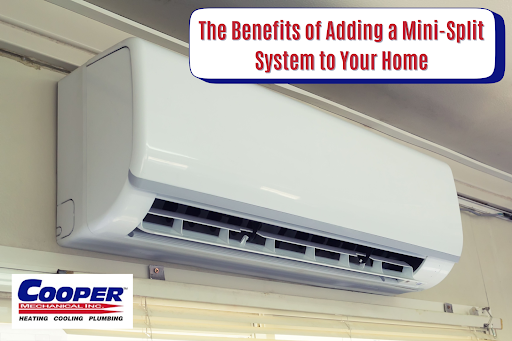As homeowners seek efficient, cost-effective, and flexible solutions for heating and cooling, ductless mini-split systems have become increasingly popular. Cooper Mechanical, based in Ottsville, PA, specializes in providing top-notch HVAC solutions, including the highly beneficial mini-split systems.
Here, The Coop will explore the many advantages of adding a mini-split system to your home.
What is a Mini-Split System?
A mini-split system, often referred to as a ductless mini-split system, is a type of HVAC system that provides both heating and cooling without the need for ductwork. These systems consist of an outdoor unit and one or more indoor units, connected by a conduit. The conduit houses the power cable, refrigerant tubing, suction tubing, and a condensate drain.
Components of a Mini-Split System
- Outdoor Unit: This is installed outside the home and contains the compressor and condenser.
- Indoor Units: These are typically wall-mounted and are responsible for distributing air within the home.
- Conduit: This connects the indoor and outdoor units, facilitating the transfer of refrigerant and power.
The Benefits of Adding Mini-Splits
1. Energy Efficiency
One of the most significant benefits of ductless mini-split systems is their energy efficiency. Traditional HVAC systems often suffer from energy loss due to ductwork, which can account for up to 30% of energy consumption. Mini-split systems eliminate this loss by delivering conditioned air directly to the desired space. This direct delivery system makes mini-splits one of the most energy-efficient options available.
2. Individual Temperature Control
Mini-split systems offer individual control over different indoor units, allowing you to set different temperatures in various rooms. This zoning capability means you can keep bedrooms cooler at night while maintaining a warmer living room during the day. This flexibility not only enhances comfort but also contributes to energy savings.
3. Easy Installation
Installing a mini-split system is generally easier and less invasive than installing a traditional ducted system. Since they don’t require ductwork, the installation process involves only a small hole drilled into the wall to connect the indoor and outdoor units. This makes mini-splits a great option for homes without existing ductwork or for add-ons and renovations.
4. Improved Indoor Air Quality
Mini-split systems often include advanced filtration options that can significantly improve indoor air quality. Multi-stage filtration systems can capture and remove contaminants like dust, pollen, and bacteria, providing cleaner, fresher air. This is particularly beneficial for households with allergy sufferers or those looking to improve their overall indoor air quality.
5. Quiet Operation
Mini-splits are designed to operate quietly, which enhances the comfort of your living spaces. The indoor units are typically very quiet, often quieter than a standard conversation, and the outdoor units are designed to minimize noise, making them less intrusive than traditional HVAC systems.
6. Cost Savings
Although the upfront cost of installing a mini-split system can be higher than traditional systems, the long-term savings are substantial. The improved energy efficiency and individual room control lead to lower energy bills. Additionally, mini-splits can operate in an energy-saving mode when rooms are not in use, further reducing operational costs.
7. Versatility and Flexibility
Mini-splits are incredibly versatile and can be used in various applications, including homes, offices, and commercial spaces. They are perfect for heating and cooling individual rooms, making them ideal for room additions, garages, or spaces that need supplemental heating or cooling. With options for wall-mounted, floor-mounted, or ceiling cassette indoor units, mini-splits offer flexible solutions for any space.
How Mini-Splits Compare to Traditional HVAC Systems
Ductless vs. Ducted Systems
Traditional HVAC systems rely on a network of ducts to distribute air throughout the home. This can lead to significant energy loss and inefficiencies, especially if the ducts are poorly insulated or have leaks. In contrast, ductless mini-splits eliminate this issue by delivering air directly to the rooms, ensuring maximum efficiency and performance.
Central Air Conditioner vs. Mini-Split Systems
A central air conditioner distributes cool air through a system of ducts. While effective for cooling large areas, they lack the zoning capabilities of mini-split systems. Mini-splits allow for targeted cooling, reducing the need to cool unused spaces and thereby saving energy.
Heat Pumps and Mini-Splits
Mini-splits often function as heat pumps, providing both heating and cooling capabilities. This dual functionality makes them an excellent choice for year-round comfort, unlike traditional systems that might require separate units for heating and cooling.
Considerations When Installing a Mini-Split System
Upfront Cost
While the initial cost of a mini-split system may be higher than some traditional systems, the investment pays off over time through lower energy bills and reduced maintenance costs.
Aesthetic Considerations
The appearance of indoor units can be a concern for some homeowners. However, modern mini-split units are designed to be sleek and unobtrusive, with options for wall-mounted, floor-mounted, and ceiling cassette models to blend seamlessly with a home’s decor.
Maintenance
Mini-split systems require regular maintenance to ensure optimal performance. This includes cleaning or replacing filters, checking the refrigerant levels, and ensuring that the outdoor unit is free from debris. Regular maintenance helps to extend the lifespan of the system and maintain its efficiency.
Mini-Split Pros and Cons
Pros
- Energy Efficiency: Reduced energy loss and lower energy bills.
- Individual Control: Customized comfort for each room.
- Improved Air Quality: Advanced filtration systems.
- Quiet Operation: Minimal noise disruption.
- Flexibility: Suitable for various applications and spaces.
Cons
- Upfront Cost: Higher initial investment compared to some systems.
- Aesthetic Concerns: Visibility of indoor units.
Contact Cooper Mechanical Today!
Adding a mini-split system to your home offers numerous benefits, from energy efficiency and cost savings to improved indoor air quality and flexible installation options. Whether you’re looking to enhance the comfort of individual rooms or seeking a reliable solution for your entire home, mini-splits provide a versatile and efficient option.
At Cooper Mechanical, we specialize in the installation and maintenance of mini-split systems. Our team of experts in Ottsville, PA, is dedicated to providing top-quality HVAC solutions tailored to your needs. Contact us today to learn more about how a mini-split system can benefit your home and improve your comfort year-round.






